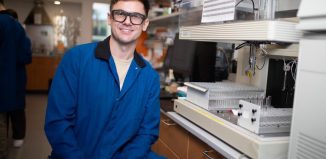SBU’s Deutsch taps into body’s own pain relief system
Some Chinese herbal remedies have had it right for many years, even if no one could point to a specific reason. Now, however, researchers at Stony Brook have figured out why some remedies taken as a tea for arthritis and pain work.
A chemical in the brain, and elsewhere, can send a signal that relieves pain, inflammation and stress. The reason pain sometimes continues, causing ongoing aches and discomfort, is that the body also has a system for breaking down or putting away its own pain-easing solution.
The Chinese remedy has an active chemical in the herb that is a truxillic acid compound. This is similar to a chemical Stony Brook scientists found that allows a pain relieving neurotransmitter, called endocannabinoid anandamide (or AEA) to remain active.
The body has a “natural marijuana system,” explained Dale Deutsch, a professor of Biochemistry and Cell Biology at Stony Brook. Deutsch has locked onto one of the key players in the breakdown of that system.
Deutsch recently received a $3.8 million, five-year grant from the National Institute on Drug Abuse to develop new drugs for pain, inflammation, and drug addiction. The research involves scientists from the Biochemistry and Cell Biology departments, Chemistry, Applied Mathematics and Anesthesiology. The research also involves the Institute for Chemical Biology and Drug Discovery, and the Laufer Center for Physical Biology.
Deutsch and his team are looking to block a protein called fatty acid binding protein. The scientists are trying to figure out if preventing these FABPs from becoming active allows AEA to continue to provide pain relief.
In drug addiction, interfering with these FABPs might reduce the pain and perhaps cravings associated with removing drugs, Deutsch said.
“In theory, if you can increase the AEA when people are coming off drugs, you may be able to help them with withdrawal, and diminish drug-seeking behavior,” Deutsch said.
The drug addiction component to this system is still at the early stages, cautioned Deutsch.
Martin Kaczocha, who identified the FABP’s role with AEA as a graduate student in Deutsch’s lab and is now an assistant professor in the Anesthesiology Department, is studying how the neurotransmitter reduces pain.
The potential upside to finding inhibitors that block the breakdown of AEA is that they work off the body’s own systems and may not have the same negative side effects as the drugs currently on the market, like NSAIDs, which, while effective can also cause stomach problems.
Tapping into this natural pain-relieving system may enable patients to feel the kind of physical relief from neuropathic pain that they might get from marijuana, without having the same psychotropic effects of the drug, he explained.
Deutsch has been studying AEA for over 20 years. In fact, towards the beginning of his work with the neurotransmitter, he discovered an enzyme that is involved in breaking down AEA. Some companies are working on drugs even now that are moving into Phase 2 trials that inhibit that enzyme, Deutsch said.
What excites Deutsch about this new FABP target, however, is that it is organ specific. That means that the transporters in the brain are different from those in the liver or other areas of the body.
The studies with the enzyme, while effective, may wind up inhibiting AEA breakdown throughout the body.
With this grant, Deutsch and colleagues, including Iwao Ojima, distinguished professor of Chemistry, Kaczocha and Robert Rizzo, associate professor in the Department of Applied Mathematics and Statistics and a member of the Laufer Center, can screen for additional compounds that might work on FABPs. So far, they’ve looked through a million possible options and expect to screen for an additional four to five million compounds within the next few years to get more potent inhibitors of the FABPs.
Deutsch credited the work of undergraduate student Brian Ralph, graduate students Bill Berger and Trent Balius and research assistant Liqun Wang as providing instrumental contributions.
Within the next few years, Deutsch and his team hope to partner with pharmaceutical companies that may develop drugs with them.
A resident of Stony Brook, Deutsch lives with his wife Lou Charnon Deutsch, an author and professor of Hispanic languages and literature at Stony Brook. Deutsch has been sailing for 20 years and especially enjoys heading to the Great South Bay.
Deutsch became fascinated with science when he received a chemistry set from his mother when he was 12.
As for his most recent efforts with FABP inhibitors, Deutsch said it “works in animals,” so he “knows we’re on the right track.”






